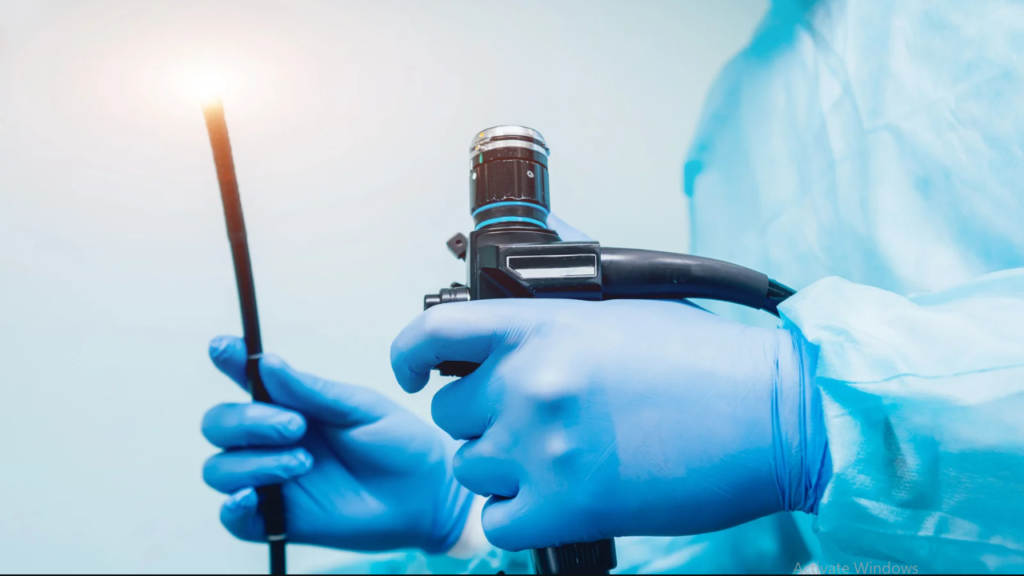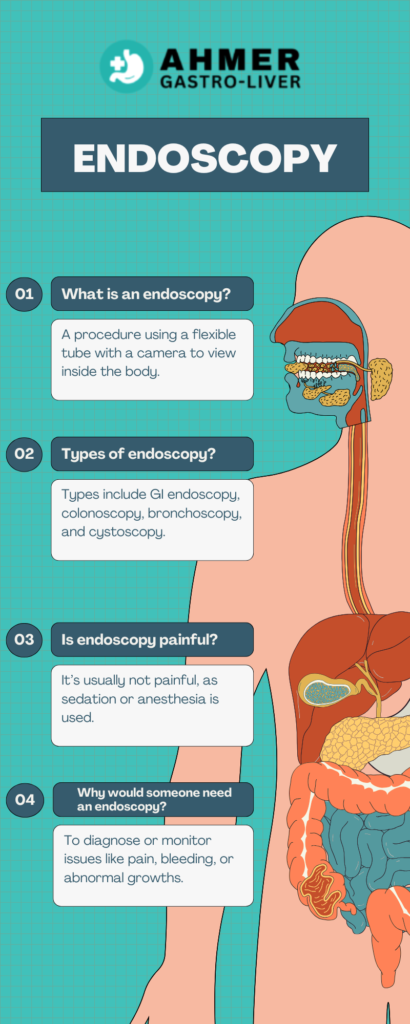
Endoscopy is the solution! During an endoscopy, a scope is inserted within the body to capture pictures or films of internal organs and structures. Endoscopies are used by medical professionals to screen for, identify, and treat a number of illnesses. Endoscopies come in a variety of forms, each intended to inspect a particular organ. Laparoscopy, upper endoscopy, and colonoscopy are a few popular varieties.
Overview
Medical practitioners can check the duodenum, the first segment of the small intestine, without surgery by doing an esophagogastroduodenoscopy (EGD).
What is an Endoscopy?
A minimally invasive technique that offers a close-up view of interior body structures is endoscopy. A thin, flexible tube (endoscope) with a camera and light is inserted into the patient’s body by the healthcare professional during the process. On a monitor, the taken pictures are shown for examination. Additionally, some endoscopes have unique channels that facilitate the insertion of surgical tools, enabling simple operations like tissue removal and biopsies.
Types of Endoscopy

Although endoscopy techniques are similar, they vary according to the endoscope type, target organ, and entrance point. Here are a few typical kinds:
- Anoscopy – Examines the anus and rectum.
- Arthroscopy – Evaluates joints for damage or conditions like arthritis.
- Bronchoscopy – Assesses the trachea and lungs via the mouth or nostril.
- Colonoscopy – Inspects the colon through the anus.
- Cystoscopy – Examines the bladder and urethra.
- Enteroscopy – Evaluates the small intestine via the mouth or anus.
- Esophagogastroduodenoscopy (EGD) / Upper Endoscopy – Examines the esophagus, stomach, and upper small intestine.
- Hysteroscopy – Views the uterus via the vagina.
- Laparoscopy – Inspects abdominal and reproductive organs through a small incision.
- Laryngoscopy – Examines the larynx via the mouth or nostril.
- Mediastinoscopy – Assesses the mediastinum (area between the lungs) through an incision near the breastbone.
- Neuroendoscopy – Examines the brain through an incision in the skull.
- Proctoscopy – Views the rectum and anus.
- Sigmoidoscopy – Examines the lower colon and rectum.
- Thoracoscopy (Pleuroscopy) – Assesses the lungs and surrounding structures through a chest incision.
- Ureteroscopy – Examines the ureters via the urethra.
Advanced Endoscopy Techniques
Less invasive endoscopic procedures have been developed as a result of medical developments. Capsule endoscopy is one such breakthrough, in which patients ingest a small capsule with a camera inside to take pictures of their digestive tract.
Uses of Endoscopy
Endoscopies are used by medical professionals to diagnose and cure illnesses. Among the important uses are:
- Screening for diseases – Colonoscopies are widely used to detect colon cancer.
- Biopsies – Endoscopes allow for the removal of tissue samples for lab analysis.
- Minimally invasive treatment – Procedures like ulcer treatment, polyp removal, and bleeding control are performed using endoscopy.
Conditions Diagnosed by Endoscopy
Endoscopy helps in detecting diseases related to:
- Digestive System – Gastrointestinal diseases, colon polyps, and colon cancer.
- Respiratory System – Lung diseases and infections.
- Joints – Arthritis and ligament injuries.
- Nervous System – Brain tumors and neurological conditions.
- Urinary System – Kidney stones and urinary tract infections (UTIs).
- Reproductive System – Endometriosis, abnormal bleeding, and fertility concerns.
Endoscopy as a Treatment Tool
Many endoscopic procedures are not just diagnostic but also therapeutic. Healthcare providers use endoscopes to:
- Seal wounds
- Remove tumors
- Stop internal bleeding
- Drain fluids
- Widen blocked or narrow organs
- Place stents
- Perform surgeries (laparoscopy is often referred to as keyhole surgery)
Preparing for an Endoscopy
Preparation varies based on the type of procedure but generally includes:
- Medical history review – Inform your provider about any medications or conditions.
- Fasting – Avoid food and drinks for a specific period.
- Bowel preparation – Required for procedures involving the intestines.
- Smoking cessation – Recommended before the procedure.
- Arranging transportation – If sedation is used, a driver is required post-procedure.
What Happens During an Endoscopy?
Most endoscopies last between 30 minutes and two hours. Typically, patients receive moderate sedation, ensuring they remain comfortable and pain-free. The steps include:
- Sedation and Anesthesia – You may be awake but relaxed or completely asleep.
- Scope Insertion – The endoscope is carefully maneuvered to the target area.
- Image Capture and Treatment – The healthcare provider examines the images and performs necessary procedures.
- Completion and Recovery – Incisions (if any) are closed, and patients are monitored before discharge.
Post-Endoscopy Recovery
After the procedure, you may experience:
- Grogginess if sedated.
- Temporary dietary restrictions.
Possible Side Effects
Most side effects subside within 48 hours. They depend on the procedure and may include:
- Mild throat irritation
- Cramps or bloating
- Temporary nausea
Understanding Your Results
The timing of results varies. Some findings are shared immediately, while others require lab analysis. Your provider will schedule a follow-up if needed.
When to Contact a Healthcare Provider
Endoscopy is generally safe, but complications can occur. Seek medical attention if you experience:
- Fever or chills (signs of infection)
- Persistent pain
- Heavy bleeding
- Difficulty swallowing or breathing
Conclusion
An essential medical procedure that helps with the diagnosis, treatment, and management of a number of illnesses is endoscopy. Effective medical interventions with quicker recovery times are made possible by its less invasive nature. Knowing what an endoscopy is and how it works will help allay any worries your doctor may have about it.
